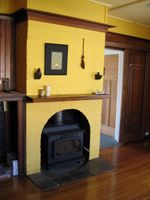Sunday, January 30, 2005
The little I learned about 'kusaki-zome ' (dyeing with dyes extracted from native plants) in Japan, where it is a centuries' old cultural art, I’ve been attempting to apply here. A plant dyestuff will produce radically different colors depending upon what type of fiber is used, and the variation can be striking: a specific variety of eucalyptus that on wool, dyes out as a deep, brick orange, dyes as a tepid gray or washed-out yellow on silk. And while the Australian literature--given that this is a wool producing country--only talks about dyeing on wool, it is dyeing on silk that attracts me. The best result I've had so far has been with Tasmanian native cherry, a feathery-looking cypress that grows all over the State. Its hue as a dyestuff depends upon the season in which the foliage is picked, and at least, in early spring, it produces an intense bronze/yellow-green. I’ve been amazed at how many distinct yellows all the various kinds of eucalptus here produce, and it would appear that God's favorite palette in Tasmania, at least on silk, is yellow. Fukumi Shimura, a textile artist in Japan, said something to the effect that each color has a world that belongs to it alone, and each signature batch of yellow indeed starts to feel like a different personality.
Friday, January 21, 2005
Thursday, January 20, 2005
Kingston Beach
Until 1930, there was prohibition on Sundays in Tasmania. But the law had a convenient enough loophole: travel more than seven miles, and it didn't apply. Kingston Beach blossomed during that time, drawing many day visitors from Hobart who ventured the 10 plus kilometers down the Channel so that they could legally drink, and the Kingston Hotel and the Australasian were the town’s favorite watering holes. The Australasian, which was down on the beachfront, advertised that it could stable up to 30 horses and 100 thirsty patrons, and a “sniff of the briny” was promised to “benefit visitors tired perhaps with the heat and worry of city life.”
I moved here in winter, so finding a house to rent was relatively easy. My yard has a grape arbor trellising the patio, as well as a fair-sized potato bed right under an apricot tree against the back fence. With the arrival of the district’s earliest settlers in the early 1800s, Kingston Beach, because of its light, sandy soil and equable climate, became known for its tasty potatoes, and in particular, the Redskin, also known as the Derwent or black potato. Tasmanians are particular about their potatoes, and each variety has a different use.
The Australasian, which was built in 1898, was sadly demolished in 1950. A grand two-story weatherboard with verandahs and romantic cast-iron corner latticework, it would have stood less than a couple of blocks away from where I live. Now, that very prime beachfront is occupied by dreary 1970s apartment blocks, with always busy take-aways on the ground floor.
(Quotes from “Brown’s River” by Julie Gardam)
I moved here in winter, so finding a house to rent was relatively easy. My yard has a grape arbor trellising the patio, as well as a fair-sized potato bed right under an apricot tree against the back fence. With the arrival of the district’s earliest settlers in the early 1800s, Kingston Beach, because of its light, sandy soil and equable climate, became known for its tasty potatoes, and in particular, the Redskin, also known as the Derwent or black potato. Tasmanians are particular about their potatoes, and each variety has a different use.
The Australasian, which was built in 1898, was sadly demolished in 1950. A grand two-story weatherboard with verandahs and romantic cast-iron corner latticework, it would have stood less than a couple of blocks away from where I live. Now, that very prime beachfront is occupied by dreary 1970s apartment blocks, with always busy take-aways on the ground floor.
(Quotes from “Brown’s River” by Julie Gardam)
Tuesday, January 18, 2005
Wednesday, January 12, 2005
Place and Origin
A friend in Kamakura gave me Rilke's "Letters to a Young Poet" to read as I was trying to come to terms with ending a 15-year-long chapter of my life in Japan. The quote I saved in my notes was: "We are born, so to speak, provisionally, it doesn't matter where; it is only gradually that we compose, within ourselves, our true place of origin, so that we may be born there retrospectively."
 ."
." 
Interior shots of the house in Kingston Beach
 ."
." 
Interior shots of the house in Kingston Beach






